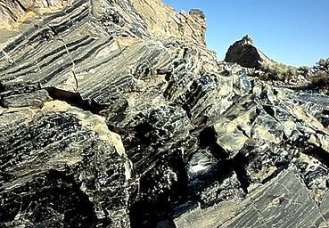



Obsidian Outcrop
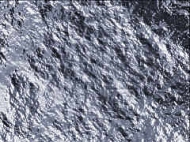 Essentially, obsidian is volcanic glass formed by rhyolite lava that has cooled very quickly. It is produced when molten igneous rock, or magma, pushes its way up to the earth's surface. It cools so quickly that the ions inside the magma do not have time to crystallise. Obsidian is usually black (due to impurities such as magnetite and hematite, both iron oxide variations) and sometimes red or brown
if iron-oxide dust, magneium and titanium oxides are present, but in the rarest occasions it has been found in mahogany, rainbow, gold sheen, silver sheen and even green. It is these deviations in colour that give obsidian a gem-like quality. Even the jet black obsidian was highly prized as a gem when it was carved and polished.
Essentially, obsidian is volcanic glass formed by rhyolite lava that has cooled very quickly. It is produced when molten igneous rock, or magma, pushes its way up to the earth's surface. It cools so quickly that the ions inside the magma do not have time to crystallise. Obsidian is usually black (due to impurities such as magnetite and hematite, both iron oxide variations) and sometimes red or brown
if iron-oxide dust, magneium and titanium oxides are present, but in the rarest occasions it has been found in mahogany, rainbow, gold sheen, silver sheen and even green. It is these deviations in colour that give obsidian a gem-like quality. Even the jet black obsidian was highly prized as a gem when it was carved and polished.
Obsidian is found in various parts of the world. It was plentiful in ancient Greece and still is in Oceania but the primary source has always been near volcanic activity of the western regions of the Americas. Obsidian implements are definitive tools of tracing trade routes. Archeologists can trace the routes because such tools are rare and the different chemical compositions in each piece can be used to determine its origin. Archeological evidence has found that North America's First Nations traded obsidian from the Pacific coast all the way to the Atlantic.
In Mexico, the Trans Mexican Volcanic Belt extends from Puerto Vallarta on Banderas Bay in the state of Jalisco all the way across the country to the Gulf of Mexico. Deposits of obsidian are present throughout this entire region with some of the most significant being in the state of Jalisco, within a hundred miles of Vallarta. A region referred to as the Tequila Valley, located in the Magdalena and La Vega lake basins near the city of Teuchitlan, Jalisco, is the location of the 9,600 feet above sea level Tequila Volcano, which last erupted about 200,000 years ago.
Obsidian, called itztli in the Nahuatl language, has been found at nearly every Mesoamerican archaeological site and can easily be dated and traced back to its place of origin. One such site in Jalisco is located in the Teuchitlan (in the Nahuatl language means the place of the first God) area which was the home of a pre-Hispanic civilization with approximately 25,000 to 50,000 inhabitants more than 2,000 years ago. This mysterious civilization which lasted until about 1,000 years ago was neither Aztec, Toltec, nor Maya. In fact, to this day, no one knows for sure who they were. The economy of this ancient metropolis, referred to as the Guachimontes site, was built on mining, working, and trading in obsidian, one of the most precious materials in early Mesoamerica. Obsidian was revered by ancient cultures and was one of the major barter materials, prized for its ability to be worked to razor-sharp edges for arrows and spears. Due to the low bulk of obsidian in transport and the resulting large quantity of useful items that could be produced from a small amount of material, it required less effort in trade which in turn contributed to obsidian’s widespread use. For many centuries, Teuchitlan was the cultural center of western Mexico with a trade network along a coastal route extending from Guatemala to Arizona. The ancient Guachimontes site consists of a number of unusual circular shaped pyramids, each with a shaft tomb. Since discovering the site in 1970 and starting formal exploration in 1999, archaeologists excavating the shaft tombs have recovered a tremendous number of obsidian artifacts including tools, weapons, jewelry, ritualistic pieces, figurines, masks, and even mirrors. This newly discovered site is of such significance that on July 12, 2006, it was added to the World Heritage List by the World Heritage Committee of Unesco. It is in a region rich in mineral wealth and obsidian
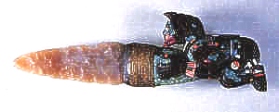 The absence of crystals in obsidian allows for a conchoidal fracture, which is a smooth yet curved break. These breaks can lead to edges sharper than a razor or a surgeon's scalpel, perfect for arrowheads, knives and other sharp instruments and weapons. The obsidian was fractured, or knapped, by striking a particular weak point in the stone, and from a particular angle. The different angles determined the thickness of the pieces broken off the original source. Someone well taught in knapping could produce several large arrowheads or dozens of thin knives from a single piece of obsidian. The art of knapping was not one mastered by everyone, rather it was a trade to be learned by skilled artisans.
The absence of crystals in obsidian allows for a conchoidal fracture, which is a smooth yet curved break. These breaks can lead to edges sharper than a razor or a surgeon's scalpel, perfect for arrowheads, knives and other sharp instruments and weapons. The obsidian was fractured, or knapped, by striking a particular weak point in the stone, and from a particular angle. The different angles determined the thickness of the pieces broken off the original source. Someone well taught in knapping could produce several large arrowheads or dozens of thin knives from a single piece of obsidian. The art of knapping was not one mastered by everyone, rather it was a trade to be learned by skilled artisans.
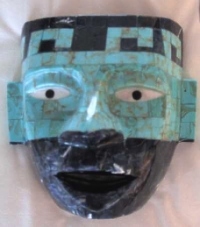 Obsidian hydration dating is a modern technology much like Radio Carbon 14 dating. Obsidian absorbs water at a known rate. By examining the amount of water within the obsidian under a microscope, archeologists are gaining much information about population patterns and migrations in the Mayan centre of Copán. In modern society, obsidian is used for a variety of items from chess pieces to piano keys. Obsidian is also being used to reproduce ancient artifacts. Mexico exports reproductions of Aztec statues and Mayan tools and American and Canadian companies sell obsidian replicas of Indian artifacts across the globe, such as arrowheads, spear points and tomahawks.
Obsidian hydration dating is a modern technology much like Radio Carbon 14 dating. Obsidian absorbs water at a known rate. By examining the amount of water within the obsidian under a microscope, archeologists are gaining much information about population patterns and migrations in the Mayan centre of Copán. In modern society, obsidian is used for a variety of items from chess pieces to piano keys. Obsidian is also being used to reproduce ancient artifacts. Mexico exports reproductions of Aztec statues and Mayan tools and American and Canadian companies sell obsidian replicas of Indian artifacts across the globe, such as arrowheads, spear points and tomahawks.
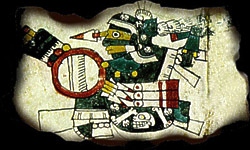 Tezcatlipoca was frequently idolised by the Aztecs in obsidian. Tezcapoctli is the Aztec name for obsidian which was used to make mirrors due to its reflective nature when polished. Obsidian tools have been found at ancient Mayan sites in Belize. Since obsidian is not found in Belize, it is believed that the Mayan sources were trades with access to Guatemala, Mexico and Honduras.
Tezcatlipoca was frequently idolised by the Aztecs in obsidian. Tezcapoctli is the Aztec name for obsidian which was used to make mirrors due to its reflective nature when polished. Obsidian tools have been found at ancient Mayan sites in Belize. Since obsidian is not found in Belize, it is believed that the Mayan sources were trades with access to Guatemala, Mexico and Honduras.
To the Aztecs, each colour was symbolic, and very real. Black was symbolic of war because obsidian was used as the razor sharp edge of the warriors war clubs and battle swords.
Obsidian is said to have healing properties, protecting the very sensitive from depression and blocking negativity of any kind. Some also claim that it is the stone of the soft and gentle hearted people of the world. More importantly, it is currently being used in cardiac surgery, as well-crafted obsidian blades have a cutting edge many times sharper than high-quality steel surgical scalpels, with the edge of the blade being only about 3 nanometers wide. Fabrication of these instruments is possible due to the fact that obsidian has no crystalline structure and can therefore be honed down to its molecular size.
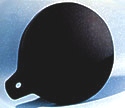 Traditionally, Catoptromancy which was a form of divination by interpreting patterns and images which appear in shiny objects such as mirrors, was practised by ancient wise men. Aztec shamans used polished Obsidian. It is said that even Queen Elizabeth I was advised by Dr. John Dee based on his interpretations of patterns in an obsidian mirror. In new age philosophy, it is still considered one of the best stones with which to see the future.
Traditionally, Catoptromancy which was a form of divination by interpreting patterns and images which appear in shiny objects such as mirrors, was practised by ancient wise men. Aztec shamans used polished Obsidian. It is said that even Queen Elizabeth I was advised by Dr. John Dee based on his interpretations of patterns in an obsidian mirror. In new age philosophy, it is still considered one of the best stones with which to see the future.
Obsidian Tidbits

Rainbow Obsidian

Aztec Obsidian Mask.

Bracelet of Obsidian and Gold
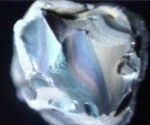
Obsidian in the "raw"
The stone at work:
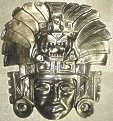
Obsidian mask
A source for this article from a site on Obsidian Artifacts.
